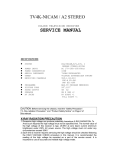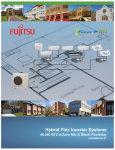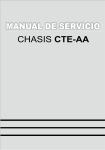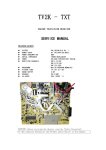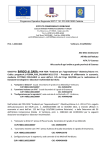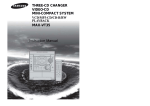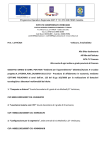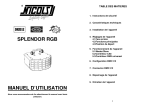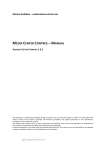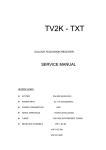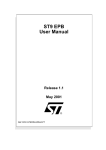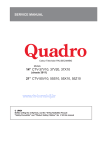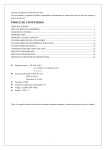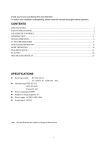Download Brown goods TV SETS 14", 21" STV2248 chasis
Transcript
SERVICE MANUAL Brown goods TV SETS 14", 21" STV2248 chasis MODELS: CTV-55A15 TXT MkII CTV-55AF15 TXT MkII CTV-37A15 TXT MkII R014 5.6K R008 5.6K R015 5.6K R011 5.6K R016 5.6K R012 5.6K R013 5.1K 100 15 16 17 18 SAW SW2 HT NC E/W RESET VHF B VHL G VSYNC R HSYNC FB VDDA 19 SDA PXFM 5V R042 20 5.1K 21 SCL JIRSTO VCC GND C005 0.22 22 23 C004 220 24 R030 6.8K 25 C028 100u/16V 26 R055 C009 0.1 27 5.6K 28 C020 4n7 JIDO WSCF WSCR VDDA VCC MCFM JTCK GND CVBS2 CVBS1 JIMS VDDA 49 CVBSO TXCF D009 3.9V 10K R049 1.2K R034 22K R035 33K V-POS IC005 24C16 R026 2.2K 41 C011 102 40 C606 4700/1KV R036 10K RL207 H.SYNC 39 R056 560 R050 1K CIS-250VAC-104K CVBS D606 FR157 21 D607 4148 R602 R607 2.7K 220K/0.5W 3 IC601 PC817 2 4 1 C613 680/1KV C208 10uF C611 15n R605 1K R604 22K C511 47u 26 27 C612 15n R680 8.2M/0.5W 6 5 NC 4 C509 1000/2KV 28 R246 75 V.AMP 2 V.SYNC 3 POWER VCC2 V AMP BC GND 7 1 R248 5.1K C312 0.047 R315 10K C333 0.01 R318 100K R317 220K R311 2.2K C331 39P/500V R312 2.2K FB R314 2.2K R313 100 C305 47u/16V R316 1.2/1W V204 C1815 D201 5.6V R328 2.2 C318 0.22 R249 47K C323 0.39/400V MUTE R633 22K R649 10K C636 1000u/35V R644 1/1W R661 15K C635 470/1KV 12V H.SYNC 10 C645 470U/16V R653 1.2K 8 ON/OFF D640 4148 V004 C1815 135V 5V C642 1000u/35V 1000u/25V C651 0.1 R631 15K HEAT T301 BCS27-0101F D308 3.9V 8V IC604 7808 C015 100u/16V R647 0.68/2W GND HV IC004 7805 NC R301 3.3K D301 4148 130V +180V R338 220K R304 560 SC IC003 UPC574 R645 22/2W V636 B892 XP302 R335 D306 HER155 0.68/1W C646 1u R636 2.2/1W R646 22/1W C327 22U/250V 33V R642 100K/0.5W C643 1000u/25V H-DY R319 1K/1W C313 47u/35V R648 15K/2W RP601 2K D637 6.2V R641 150K/0.5W L301 37UH R327 22K/0.5W V401 C1815 R643 5.6K V631 C1815 V-DY 24V D303 HER155 R415 10K C231 470u/16V R247 1K MUTE7057 R632 47K/0.5W R331 220/1W R343 330/2W R324 470/2W V205 A1015 7 R336 2.2/5W 24V R332 270/2W 20V 4 C641 x FV 3 BC D207 4148 HD C319 0.1 C316 1u/160v C302 4.7u/16V 2 R323 1K 0.5W D307 4148 9 1 R308 15K R306 22K V302 2SD2499 L304 C304 3900/500V SV 24V T302 YDD-UU10.5 V301 C2383 C303 1000/500V PART No : ST29TEX 8 100u/35V R239 75 G C212 47u/16V C637 C681 2200/400V 9 10 D302 1N4002 11 V.SYNC IN R321 2.2K VCC1 C311 1000 V OUT R334 2.2K FLYV IC301 TDA8174 R333 1.8K C315 4.7u VP V303 C1815 R329 10k 5V(A) D635 FR305 L801 C501 * HEAT VIDEO2 IN L2 R2 BOUT NC V.POSITION R326 8.2K 8V FBEXT REXT GEXT 25 R214 150 J023 75 C647 1000u/16V V602 C3807 C521 100 R240 75 B R220 75 R613 33/2W V603 2SD2498 R521 560 GND Go Bo 29 C210 1u C211 10uF C633 470/1KV C610 0.1 +5V AC110~240V 50/60HZ 30 GOUT Icath ROUT 31 BEXT APR 24 D633 29 XP602 FBEXT Ro 8V REXT GEXT BEXT V1 IN 23 C203 1u 470/1KV HER204 R609 15K D608 4148 R513 1.2K D505 4148 C314 22 C634 D609 7.5V S601 XP601 1UF 1UF C226 C228 1UF L1 IN BOSD CHR Y/CVBSIN3 BS 20 T602 BCK-42-31EC CIS-250VAC-224K L501 150uH 180V 1UF C227 1UF C411 C412 R1 IN L OUT V OUT OSD B R OUT GOSD ROSD FBOSD 32 V.SYNC 24V CVBSIN2 XTAL2 XTAL1 XTAL3/BTUN GND2 CVBSIN1 Vcc2 33 D632 C644 HER308 220u/160V D634 HER204 RT601 MZ72-14RM R606 3.3K R057 15K 34 R212 1K R603 22/0.5W V601 A1015 C601 F601 3.15A/AC250V C025 0.1 OSD R OSD FB C219 4700 CLPF PIFLC2 C201 1u 36V D605 4148 R531 2 15K R532 *2.2/1W C511 47u/16V R222 270 R230 75 R 12V 8V L003 10uH 19 35 C632 470/1KV R615 120K/0.5W L601 BCK UU-16 31 18 R614 68K/2W C609 x 33 C019 2n2 17 C604 R608 5.6K/0.5W C602 D007 1K 30 R611 120K/0.5W YDDUF16 R059 5.6k C022 0.47 C021 100 C608 BCK UU-16 CD293-400V-100uF-M L602 1000/1KV LED 339EVGW 35 C607 x C605 x 37 34 X D604 D601 D602 L001 10uH 38 C033 22P 16 36 D603 R601 2.2/7W R221 270 12V 37 D208 4148 R409 2.2K V.SYNC R218 270 L102 7K001 VHL D604 1N4148 36 15 R529 3.3K/0.5W C2482 R518 330 R523 27 R512 470 C504 680 V507 C505 1015 47u/16V R517 1K D504 4148 R207 150 VHF R005 100 42 14 38 C117 47u/16V 44 R006 100 OSD G BLNK 13 39 C202 470u/16V WOOFER.MUTE 45 43 GND1 CVBSOUT1 HOUT Vcc1 12 C114 0.01 C113 0.22 C405 1u 0.1 40 5V 47 46 V.AMP C215 470u/16V C214 2.2u/16V SLPF VIDEO OUT 8V BCL AUDIO WF.SW 20V GND HD SC SCL V.SYNC 11 C116 * Z101 Q3962 8 1.2K SDA SCL Vcc D507 10 5 D703 IN4001 R708 5.1K C705 2.2u/25V C452 47u/16V C453 2.2u/16V 0.1 R452 4.7 C458 AUDIO SCL VERT 10 C406 1u R507 15K 2 X203 41 R204 560 R044 V002 R033 C1815 48 32 9 R118 1K C118 C119 10u 0.01 10K R041 V003 C1815 C024 4n7 5.1K R021 8 42 V505 V506 C1815 C317 1000u/25V C006 33 50 C026 0.1 R018 7 GND R511 560 8V R-VOL 6 C109 1u 43 C IN SW1 5 R225 75 CRT R508 3.3K/0.5W C506 560 X201 3.58M VIDEO2 IN NC V-POS 4 R516 2 15K R501 330 R524 27 R502 470 8V POWER.GND YUV SCART2 VOL 3 C115 1u V502 C1815 C218 0.01 VIDEO1/Y IN 13 14 SCART1 2 D008 4148 6 OSDOUT C013 0.1 X001 4M 51 7 FAC-IN OSDIN SDA FMCAP 1 RESET 52 WP POWER NC 44 C603 220/1KV R040 5.1k L001 10uH NC 45 PIFLC1 X1/VAMP/CHROUT R037 3.3K 53 C217 0.1 46 EXTAUDIO 12K 47 AGC 12 R010 1k C003 0.1 33K VT C001 0.1 R515 3.3K/0.5W XS201 RO BO R217 1K X202 4.43M 4 GND SDA 5 11 J R020 5.6K 22k 48 IC101 STV2248 Vcc 10 R007 33V R001 A0 9 J XP005 KEY 22K R002 C216 0.1 R234 1K 49 INTCVBSOUT 54 C027 0.1 50 C221 0.01 C222 0.01 R233 18K C224 0.22 VccIF R039 R022 22K 10K 8 10K XP005 V001 C1815 51 R211 1K R231 X BCL/SAF C012 150 55 52 R514 330 V501 R232 82K AM/FMOUT VT S-BYLED 56 53 R525 27 R509 470 C507 680 V OUT R403 R404 10K 10K R235 56K R227 5.1K R215 15K C206 0.01 54 V504 C2482 C2482 5V(A) MUTE NC 55 VIDEO OUT XP702 GND IF AV KEY-IN 56 C402 1u R208 75 R202 560 WOOFER IFPLL RESET SDA TVR C207 1u 5V 10K C213 4700 CRT BOARD V503 C1815 GO R307 1K LFB/SSC IRIN C205 47u/16V R201 75 V203 1815 8V R405 10K C702 22u/25V D206 4148 R226 100 R229 100 L2 R406 10K R701 J C701 0.22 R236 8.2K C103 0.1 C204 10u 16V C709 0.22 XP403 D205 4148 RO R241 75 AV OUT C403 1u R401 560 R242 75 R025 100K R700B 6.2K Z102 Q9350 C104 0.1 R711 1 R402 560 LO R213 75 XP701 5V(A) MUTE 20V AMP LO AMP RO LO RO L2 R1 GND NC IF D101 5.1V R701B 3.9K SCL R023 10K R024 6.8K Vcc R702B 2.2K C007 33 5 R004 SCL R703B 1K R114 100 R485 100K 7 SDA SW6 P+ R464 220 C707 10n D702 1N4001 R702 10K TUNERAGCOUT 3 6 OSD FB SW5 P- C455 4.7u/16V SIFIN1 2 R019 100K OSD R SW4 V+ C454 1u R413 100K R414 47K R038 1 RE HS0038 GND 4 OSD G R704B 9.1K R203 33 RESET OSD B SW3 V- 1K C408 47u/16V R028 OUT ICMUTE XP002 PIN2 C441 1000u/25V SW2 MENU R705B 15K 11 C111 47u R451 1K C443 2.2u/16V IC001 ST92195 VCC BLNK 10 R463 5.6K R461 R103 10K R053 10k ON/OFF 9 2 R448 10K PIFIN1 8 5.1K R106 33K C014 0.1 5 4 C445 4.7u/16V AGCPIFCAP 7 C108 0.1 R107 R051 10 NC NC 6 SW1 OK 7 R238 75 C710 1000u/25V C711 1u V701 C1815 KEY R102 10K R054 100 5V 2 D401 3.6V 3 A2 5 VCC BL BH 4 C102 0.1 AGC D441 4148 7 5 4 8V C107 0.1 C112 47u/16V C461 4700 15 C449 0.1 VHF-I VHF-II 14 R710 22K C703 10u/25V V702 C1815 10K Vcc D 13 100K R712 GND D 12 6 Vref IF 11 3 AGCSIFCAP 10 IC403 TDA1905 9 10 11 12 13 14 15 16 R462 4.7 R454 220 8V 9 6 8 C448 0.1 C442 47u/16V C444 1u 3 TDA1905 2 A1 3 9 10 11 12 13 14 15 16 16 1 2 BU VT AGC 1 17 TVL 8 TUNER VT C446 0.1 18 R706 100K R707 100K 1 C456 0.1 AUDIOOUT 19 R705 R704 0.22 SIFIN2 2.7K R424 R423 5.6K 20 R453 5.6K IC402 8 C424 10n 0.1 C423 22n 21 C459 0.1 1 R411 1K 1K 7 TO AMP RO TO AMP LO 8V SDA C401 10u SCL 6 5 22 TVL 4 23 C462 4700 TDA7439 R2 3 R412 2 100 R416 1 5.6K 24 C422 R421 25 0.1 C421 0.1 22n C417 0.1 2.7K 26 IC401 TVR 27 L1 28 C418 5600 C415 10n R422 C414 5600 29 C416 C413 30 D451 4148 V2 R2 R237 75 C706 1000u/25V D701 5.1K 5.1K C457 470u/25V C425 C426 4.7u/16V 4.7u/16V 4 WOOFER BOARD C447 470u/25V MAIN BOARD 2 1 SCH21ST9JL R455 R SCART TDA2030 IC701 5.1k 3 R456 XP401 NC AV IN XP402 L PIFIN2 SPEAK SCHEMATIC DIAGRAM 1.RESISTANCE VALUES INΩ1/4W UNLESS OTHERWISE SPECIFIED. 2.CAPACITANCE VALUES IN uF50V IF LESS THAN 1 AND IN pF50V IF MORE THAN 1 UNLESS OTHERWISE SPECIFIED. 3.CIRCUITRY ARE SUBJECT TO CHANGE WITHOUT NOTICE FOR FUTHER IMPROVEMENT. C321 470/2KV C332 *1n5/1.6KV R341 8.2K C322 103/1.6KV C326 0.47/630V D304 FR305 C309 47n TABLE OF CONTENTS S/N 1 2 3 4 5 6 TOPIC Page # INTRODUCTION 1.1Definitions , Acronyms and abbreviations 1.2References SPECIFICATION SUMMARY 2.1Hardware 2.2Tuning 2.3Control 2.4OSD(On Screen Display) 2.5Sound 2.6Peri-TV 2.7Memory 2.8Power ON 2.9Standby 2.10Adjustments BASIC HARDWARE DESCRIPTION 3.1 BASIC HARDWARE SPECIFICATION 3.2 MICROCONTROLLER ST92195 3.4 MULTI STANDARD TV PROCESSOR STV223X/4X 3.5 MULTI STANDARD SOUND DEMODULATOR STV8203A 3.6 SOUND PROCESSOR TDA7449/TDA7439 3.7 E_W CORRECTION PROCESSOR STV9306 3.8 REMOTE CONTROL TRANSMITTER M3004LAB1 4 4 4 5 5 5 5 5 6 6 7 7 7 7 9 9 9 9 9 9 10 10 ST92195 PIN DESCRIPTION 4.1 RESET 4.2 R, G, B BLANK 4.3 XTAL 4.4. BAND SWITCHING OUTPUT 4.5 AV STATUS 4.6 KEYBOARD INPUT 4.7 POWER MODE CONTROL 4.8 I2C LINES 4.9 SAW SWITCHING FUNCTIONAL DESCRIPTION 5.1Interface Description 5.2Tuning 5.3Sound System USER INTERFACE 6.1Direct Controlled Function 6.2Menu Controlled Function 11 13 13 13 13 13 13 13 14 14 15 15 19 20 21 21 26 7 6.3Service Controlled Function Appendix A :IR Commands 35 40 1. INTRODUCTION CTV5 is a Voltage Synthesis Tuning and control system for multi-standard TV receivers with on-screen-display (OSD) for all relevent control functions. The system is based on I2C bus controlled video processing IC STV223X/4X which also controls mono sound. The Nicam and Zweiton demodulation is done using IC STV8203. It is also possible to do picture geometry correction using IC STV9306. The user interface is menu based control system with P+ ,P- ,V+ , V- , MENU OK and TV/AV keys on Remote / local keyboard . Hence any menu related function could be accessed using these six keys. Teletext is done by the microcontroller on-chip teletext module. 1.1 Definitions , acronyms and abbreviations ADC AFC AV DAC I2 C IDENT FE LS MS NV-memory OSD PP VST Video proc. PIF SIF NICAM Analogue to Digital Converter Automatic Frequency Control Audio Video peripheral TV signal source Digital to Analogue Converter Inter IC bus, 2-wire, bidirectional multi-master bus Horizontal coincidence signal, transmitter IDENTification Front End Loud Speaker Multi Standard Non-Volatile memory On Screen Display Personal Preference Voltage Synthesis Tuning STV2238, integrated I2C bus controlled PAL/SECAM/NTSC TV-processor Picture Intermediate Frequency. Sound Intermediate Frequency. Near Instantaneous Companded Audio Multiplex 1.2 References ST92195 Datasheets STV223X/4X Datasheet STV8203A Datasheet TDA7439/7449 Datasheet STV9306 Datasheet 2. SPECIFICATION SUMMARY 2.1 Hardware The microcontroller has 24/32/48/64K ROM, 256 bytes RAM, 0/256/512 bytes Aux RAM, bitlevel I2C, on-chip 0/1/7 page teletext, OSD. 2.2 Tuning | | | | | | | | | Voltage synthesis tuning system via 14-bits PWM-DAC. Automatic search tuning based on AFC and IDENT. Tuning in VST system in 3 bands (VHF-L,VHF-H,UHF). Fine up and down tuning. Auto Program function to find and store all transmitters. Automatic PAL/SECAM/NTSC recognition. Suitable for negative and positive modulation. Programme-Up/Down keys to select 99 programmes. Silent tuning. 2.3 Control | | 8 Local Keys (P+, P- , V+ , V- , Menu , OK, TV/AV ,Service) Max 32 Remote Keys 2.4 OSD ( On Screen Display ) MENU CONTROL Picture Menu Brightness (64 Steps) Contrast (64 Steps) Colour (64 Steps) Sharpness (16 Steps) Tint ( 64 Steps , Only for NTSC) Sound Menu Bass (64 Steps) Treble (64 Steps) Balance (16 Steps) Volume (64 Steps) Install Menu Auto Tune Manual Tune Fine Tune (+ - 64 Steps from centre frequency ) Store . Setup Menu The Setup Menu contains 4 submenus: Timer Time (Hour = 0 ... 23 , Minute = 0 ... 59) On Timer (Hour = 0 ... 23 , Minute = 0 ... 59) Off Timer (Hour = 0 ... 23 , Minute = 0 ... 59) On Timer Pr ( 1 ... 99 ) Organize Program ( 1 ... 99) Label (4 digit with each program , A to Z , + ,-, SPACE , 0 to 9) Picture ( AUTO / PAL , SECAM , NTSC1, NTSC2) RF Std ( BG , DK , I , LL’, MN ) for Europe Skip ( Yes / No ) Function Blue back (Yes/No) Children Lock (Yes/no) Language English French German Italian Spanish Portuguese Greek Dutch Danish Swedish Finnish. Norwegian. 2.5 SOUND : | Volume control in 64 steps . | Stereo Sound . | Multistandard Nicam and Zweiton demodulation. | Automatic mute during program change. | Fully suitable for FE -sound output on AV1 connector. 2.6 PERI-TV : | AV has FE audio /video input / Output , RGB inputs (Full SCART) | Auto SCART level detection 2.7 MEMORY : | Storage of last Sound and Picture settings. | Storage of last Channel, Power status. | Storage of Tuning information of the 99 programs. | Storage of Label of 99 programs (Each of 4 characters) | Storage of Service settings . | Storage of Alarm settings. | Storage of Nicam / Zweiton standard of 99 programs. | Storage of Child-Lock value. | Storage of Customer character LOGO. 2.8 POWER ON : | If the TV is in ON state before the mains switch is made OFF , at power-on-reset via mains switch ,the TV goes in to POWER ON mode . If the Set is in Standby before the mains switch is made OFF, at power-on-reset via mains switch ,the TV goes in to Standby mode. | The program provides a fixed delay of 1 second and screen blanking of about 500 msec to allow SMPS to stabilise. | After power-on-reset of microcontroller and first time switching of the set, the system tunes to program 1 and recalls analog picture and sound controls from the EEPROM. | If the set is in standby , the TV set comes out of standby using Digit keys , P+ and P- keys. 2.9 Standby : | Sleep timer selection of in steps of 10 minutes till a maximum of 120 minutes. Automatic switching to standby mode when there is no valid signal for 5 minutes. 2.10 Adjustments Initialize EEPROM (ROM default values programmed into EEPROM). Through Service menu-1 the following parameters could be adjusted: | Adjust Red Gain | Adjust Green Gain | Adjust Blue Gain | Adjust DC Red | Adjust DC Green | Adjust DC Blue | Adjust APR threshold | Input the customer character LOGO. | Adjust Red cutoff. | Adjust Green cutoff Through Service menu-2 the following parameters can be adjusted: | Adjust Tuner AGC | Adjust H-position | Adjust V-position | Adjust V-amplitude | Adjust Sub_tint | Adjust Sub_brightness | VCO Coarse. | VCO Fine. | VCO Coarse L’ | VCO fine L’ Through Service menu-3 (STV9306, if there is no STV9306 then this menu is not displayed): | Adjust V-Amplitude (50Hz/60Hz). | Adjust V-Position | Adjust C-Correction | Adjust S-Correction | Adjust H-Amplitude | Adjust EW-Amplitude | Adjust EW-Trap | Adjust EW-Shape Through Service menu-4 (Design menu) following parameters are adjusted | Adjust Tuner AGC gain. | Adjust Option1 | Adjust Option2 | Adjust Option3 | Adjust Option4 | Adjust Option5 | Adjust Sttext | Adjust HPOS_OSD | Adjust VPOS_OSD | Adjust HPOS_OSD_Teletext | Adjust VPOS_OSD_Teletext 3. BASIC HARDWARE DESCRIPTION 3.1 Basic Hardware Specification The CTV5 system has following components : | ST92195 MCU + OSD + TXT controller with CTV5 software inside. | 24C08 1K byte Non Volatile memory (EEPROM). | STV2238/46/48 Bus Controlled Multi-standard TV Processor. | STV8203A Bus controlled Multistandard TV Sound Demodulator. | TDA7439/7449 Bus controlled Audio processer. | STV9306 Bus Controlled Vertical deflection system with E-W correction output circuit. | M3004LAB Remote Controlled Transmitter. | Voltage Synthesis Tuner. Communication between microcontroller (master) and all I2C bus controlled devices (slaves) is done using a two-wire bidirectional I2C bus. 3.2 Microcontroller ST92195 Microcontroller + OSD +Teletext decoder + VPS/PDC/WSS decoder are embedded in one chip. For the details of microcontroller please refer to the ST92195 data sheet. 3.3 Non Volatile Memory 24C08 The 24C08 is a 8K-bit 5V electrically erasable programmable read only memory (EEPROM), organised as four pages of each 256 by 8 bits. Data and instructions are transferred via the I2Cbus. Minimum programming time is 10 ms. Data retention is at least 10 years, independent of the power-on/off status. The number of erase/write cycles per address is greater than 105 for 24C08B. 3.4 Multi Standard TV Processor STV223X/4X STV223X/4X is a fully bus controlled IC for TV including PIF, SIF , Luminance , Chrominance and deflection processing. It is a bus controlled PAL / SECAM / NTSC single chip TV Processor. For details of STV223X/4X features please refer to the STV223X/4X datasheet. 3.5 Multi Standard Sound Demodulator STV8203A The STV8203A provides all the necessary circuitry for demodulation of all Nicam and German Stereo audio transmission. For details of STV8203A features please refer to the STV8203A datasheet 3.6 Sound Processor TDA7439/TDA7449 The TDA7439/7449 is a volume tone (bass and treble) balance(Left/Right) processor for quality audio. TDA7449 provide 2 stereo inputs while TDA74439 provide 4 inputs. For details of TDA7439/7449 features please refer to the TDA7439/7449 datasheet 3.7 E-W Correction processor STV9306 The STV9306 is a fully bus controlled IC for vertical deflection and designed for use in 110° , 4:3 or 16:9 CRT application. It integrates both vertical deflection and E-W correction circuit necessary for design of 110° chassis 3.7 Remote Control Transmitter M3004LAB1 See Appendix -A . For details see M3004LAB1 datasheet. IR IN RESET NC MUTE 56 KB INPUT 55 NC 1 2 3 54 VS OUT 53 LED1 52 LED2 4 NC 5 ON/OFF 6 DESIGN 7 SCART1 8 51 XTAL SCART2 9 AV SEL 10 S0 11 S1 12 NC 13 NC 14 ST9219 50 XTAL 49 VOL PWM 48 47 Vlin PWM 46 45 SAW-SW2 NC 44 SAW-SW1 43 NC G 16 41 BSW2 BSW1 VSYNC R 17 FB 18 40 HSYNC B 15 42 39 AVDD1 38 PXFM SDA 19 SCL 20 37 JTRST0 36 GND VDD 21 JTDO 22 WSCF 23 WSCR 24 AVDD3 25 TEST0 26 MCFM 27 28 JTCK 35 AGND 34 TELETEXT 33 WSS 32 JTMS 31 AVDD2 30 CVBS0 29 TXCF 4. ST92195 PIN DESCRIPTION Pin 1 2 3 4 5 6 Pin Name P2.0 RESET P0.7 P0.6 P0.5 P0.4 Signal Name IRIN RESET NC MUTE NC ON/OFF I/O I I I/O O I/O O Function IR Input Hardware Reset Not Used MUTE OUTPUT PIN Not Used STANDBY OUTPUT 7 8 9 10 11 12 13 14 15 16 17 18 19 20 21 22 23 24 25 26 27 28 29 30 31 32 33 34 35 36 37 38 39 40 41 42 43 44 45 46 47 48 49 50 51 52 53 54 55 56 P0.3 P0.2 P0.1 P0.0 P3.7 P3.6 P3.5 P3.4 B G R BLANK P5.1 P5.0 VDD JTDO WSCF WSCR AVDD3 TEST0 MCFM JTCK TXCF CVBSO AVDD2 JTMS CVBS2 CVBS1 AGND GND JTRST0 PXFM AVDD1 HSYNC VSYNC P4.0 P4.1 P4.2 P4.3 P4.4 P4.5 P4.6 P4.7 XTAL XTAL P2.5 P2.4 P2.3 P2.2 P2.1 DESIGN SCART1 SCART2 AV SEL S0 S1 NC NC B G R BLANK SDA SCL VDD JTDO WSCF WSCR AVDD3 TEST0 MCFM JTCK TXCF CVBSO AVDD2 JTMS CVBS2 CVBS1 AGND GND JTRST0 PXFM AVDD1 HSYNC VSYNC BSW1 BSW2 SAW_SW1 NC SAW_SW2 NC Vlin PWM VOL PWM XTAL XTAL LED2 LED1 VS NC KB INPUT I I I O O O I/O I/O O O O O I/O O I I I I O O O I/O O I/O O O O O O I/O I Service menu control Identify scart entering Identify scart entering AV SELECTION AV/TV AV/TV Not Connected Not Connected OSD Blue colour Signal OSD Green colour Signal OSD Red colour Signal OSD Blanking Output I2C data line I2C clock line +5 V Digital Supply Test Pin Analog Pin For VPS / WPP Analog Pin For VPS / WPP +5V Analog VDD For PLL Test Pin Analog Pin for display pixel Test Pin Analog pin for VPS /WSS Test Pin Analog Power supply Test Pin CVBS In for VPS / WSS CVBS In for Teletext Slicer Analog Ground Digital Ground Test Pin Analog Pin for display pixel Analog Power Supply Horizontal Sync Input Vertical Sync Input Band Switch 1 Band Switch 2 SAW Filter Switch 1 Not Connected SAW Filter Switch 2 Not Connected V-linearity PWM OUTPUT VOL PWM OUTPUT Clock Oscillator Clock Oscillator LED DRIVER LED DRIVER VST Voltage Ouput Not Connected KEY INPUT 4.1 RESET : Reset is active low Input. The ST9+ is initialized by the Reset Signal. With the deactivation of RESET , program execution begins from program memory locations 00h and 01h. 4.2 R,G,B,BLANK : Red / Green / Blue / Fast Blanking. On Screen Display DAC outputs. 4.3 XTAL : These pins connect a parallel resonant crystal of 4 MHz. 4.4. BAND SWITCHING OUTPUTS : BSW1 BSW2 0 0 0 1 1 0 1 1 SELECTED BAND NOT USED VHF_L VHF_H UHF 4.5 AV STATUS : 4.5.1 SCART 1 / SCART 2 (pin 8 & pin 9) SCART_SW pin of the microcontroller monitors the status of the AV SCART Connector. When the signal at this pin goes from low to high , the set will automatically switch to AV and when it goes from high to low the set will automatically switch to the previous source. 4.5.2 AV SELECTION (pin 10) 10 pin status 0 1 AV MODE AV1 / RGB AV2 / S-VHS 4.5.3 TV / AV SELECTION (11 pin / 12 pin ) S0-11 pin 0 1 0 1 S1-12 pin 0 0 1 1 TV / AV MODE TV AV1/RGB AV2 S-VHS 4.6 KEYBOARD INPUT : It is ADC input of the micro. The Voltage at the select ADC Pin of the micro is monitored and depending on the voltage value at this pin it is decided as to which key is pressed. KEY IN (Pin 56) KEY PRESSED 0.3~ 0.7V Volume – (120 ohm) 0.8 ~ 1.2V Volume +(270 ohm) 1.3 ~ 1.7V Program-(470 ohm) 1.8 ~ 2.2V Program+(680 ohm) 2.3 ~ 2.7V MENU(1 Kohm) 2.8 ~ 3.2V OK(1.5 Kohm) 3.3 ~ 3.7V AV/TV(2.2 Kohm) 3.8 ~ 4.2V Analog(3.3 Kohm) 4.7 Power mode control : The STD-BY Output specifies if the set is in Stanbby mode or operating mode. STD-BY Mode (Pin 6) 0 Standby 1 Operating 4.8 I2C Lines : Pins 19 (SDA) and 20 (SCL) of the MCU are the I2C Lines. The I2C bus is a 2 wire bidirectional bus. The CTV5 has an on-chip bit level I2C interface . This means the hardware takes the bus arbitration , the reception and transmission of data bits and generation of START and STOP condition. The software must handle the bits (i.e save a received bit and prepare the bits which must be transmitted. ) CTV5 supports 1K bytes EEPROM (ST24C08) used for storage of analog controls , Service settings, Alarm Settings, tuning data for 99 pre-selected programmes and label for each of them. The I2C address of the EEPROM is shown in the next chapter. The Video processor STV223X/4X is controlled via I2C on address 8A hex. 4.9 Design pin 7: It is available to enter SERVICE MENU when it is high for the voltage at pin 7 of MCU. It is forbidden to enter the SERVICE MENU when the voltage level is low at pin 7 of MCU. 5. FUNCTIONAL DESCRIPTION This section describes all functions and hardware requirement of CTV5. Overall control of the system is done by the microcontroller which : | Decodes the data from the Remote controller. | Decides on which local key is pressed | Controls the On Screen Display. | Exchanges information via I2C bus. | Selects the proper tuner band and generates the 14 bit data for the internal Voltage synthesised tuning DAC. | Selects proper IF and Sound demodulator. | Selects proper Nicam /Zweiton decoder/demodulator . | Controls analog picture settings and picture geometry. | Switches between internal and external audio and video signals. 5.1 Interface Description : 5.1.1 Remote Control Handset : A remote control handset compatible with CTV5 can be designed using M3004LAB1. 5.1.2 Remote control decoding : The infra red remote control pulses are modulated at a frequency of 38 Khz .The remote control signal (active high) from the IR receiver is fed to the external interrrupt input IR-INPUT (pin 1) of the microcontroller. The following table lists all remote commands to which standard remote control responds to. Name 0 1 2 3 4 5 6 7 8 9 TENS(-) Review Standby Mute Sleep PP(VSM) Audio PP Analog Recall Menu Code 0x10 0x11 0x12 0x13 0x14 0x15 0x16 0x1e 0x18 0x19 0x1a 0x28 0x20 0x36 0x09 0x2e 0x2d 0x33 0x2a 0x2b TV Mode 0 1 2 3 4 5 6 7 8 9 TENS Channel review Power on/off Mute/unmute Sleep Vedio PP Audio PP Audio adjust Status recall Menu switch Menu Mode 0 1 2 3 4 5 6 7 8 9 Power on/off Mute/unmute Channel move P+ P- 0x1c 0x1b Channel+ Channel- V+ V- 0x24 0x25 Volume+ Volume- Menu item up Menu item down Increase value Decrease value AV 0x29 Sourse changed Channel delete Service NICAM OK 0x05 0x35 0x2c Service in NICAM - Txt Index Size Mix 0x31 0x01 0x0e 0x0c Enter txt Sub menu enter - Service Mode A Power on/off Line gain adjust Service exit TXT Mode 0 1 2 3 4 5 6 7 8 9 Reveal Power on/off Sub brightness GREEN key CYAN key YELLOW key Auto center VCO Item up Item down Run_time _mode _choice Page plus Page minus Value+ ValueAuto adjust VCO Menu switch - RED key Exit txt Index Size Mix Cancel Stop Reveal Subcode 0x0b 0x06 0x0a 0x04 Cancel Stop Reveal Subcode 5.1.3 Non Volatile Memory : The CTV5 tuning and sound system requires 1KBytes non volatile memory (24C08). With such a memory the system is able to stores tuning information and label of the 99 preselected programs along with the last picture /sound control settings, Service and Alarm Settings. The following is EEPROM Address map defined in EEPROM.h: Signature Byte (address = 0 & 1023): Value = 0xDC Service Signature Byte (address = 1 & 1022): Value of service in= 0x66, Value of service out= 0x99. Power related byte (address =3): EEPROM_TV_OPTIONS EEPROM_STANDARD_SELECTION EEPROM_P_PP EEPROM_S_PP EEPROM_LAST_CHANNEL EEPROM_LANGUAGE EEPROM_POWER_STATUS START VIDEO Byte(address = 10): EEPROM_BRIGHTNESS EEPROM_CONTRAST EEPROM_COLOR EEPROM_SHARPNESS EEPROM_TINT EEPROM_VOLUME EEPROM_BALANCE EEPROM_BASS EEPROM_TREBLE Service RGB Byte (address = 19) EEPROM_RED_GAIN EEPROM_GREEN_GAIN EEPROM_BLUE_GAIN EEPROM_DC_RED EEPROM_DC_GREEN EEPROM_DC_BLUE EEPROM_APR_THRESHOLD EEPROM_RED_CUT_OFF EEPROM_GREEN_CUT_OFF Service Byte (address = 28) EEPROM_AGC EEPROM_HORIZONTAL_SHIFT EEPROM_VERTICAL_POSITION EEPROM_VERTICAL_POSITION_60 EEPROM_VERTICAL_AMPLITUDE EEPROM_VERTICAL_AMPLITUDE_60 EEPROM_BRIGHT_MAX EEPROM_BRIGHT_MIN EEPROM_SUB_TINT EEPROM_PLL1 EEPROM_PLL0 EEPROM_PLL1_L1 EEPROM_PLL0_L1 Design Byte (address = 41) EEPROM_AGC_GAIN_ADJUST EEPROM_MISC1 EEPROM_MISC2 EEPROM_MISC3 EEPROM_MISC4 EEPROM_MISC5 EEPROM_MISC6 EEPROM_HPOS_OSD EEPROM_VPOS_OSD 16 EEPROM_HPOS_OSD_TELETEXT EEPROM_VPOS_OSD_TELETEXT Service STV9306 Byte (address = 52) EEPROM_V_SAW50 EEPROM_V_SAW60 EEPROM_V_SH50 EEPROM_V_SH60 EEPROM_V_SC EEPROM_V_CC EEPROM_EW_VDC EEPROM_EW_AMP EEPROM_EW_SHAPE EEPROM_EW_TRAP EEPROM_S_BRIGHTNESS(address =62) EEPROM_S_COLOR(address =63) EEPROM_S_CONTRAST(address =64) Alarm Byte (address = 65): EEPROM_ALARM_SET EEPROM_ALARM_CHANNEL EEPROM_ALARM_ON_HOUR EEPROM_ALARM_ON_MINUTE EEPROM_ALARM_OFF_HOUR EEPROM_ALARM_OFF_MINUTE Child Lock Byte (address = 71): EEPROM_CHILDKEY_CODE1 EEPROM_CHILDKEY_CODE2 EEPROM_CHILDKEY_CODE3 EEPROM_RUN_TIME_CHOICE_TABLE (address = 74) LOGO data : (start address = 80 or 0x50 ) Offset bit 7 bit 6 bit 5 bit 4 bit 3 bit 2 bit 1 0 Lenght should < MAX_LOGO LENGTH =12 (ASCII char) 1-12 LOGO characters (ASCII char) bit 0 Tuning Data : (Offset=96,Total = 99 * 3 Bytes) bit 7 bit 6 bit 5 bit 4 bit 3 bit 2 bit 1 bit 0 0 Band Band Tuning Value bit 13 .... 8 1 Tuning Value bit 7 ..... 0 2 Chroma Standard Skip Super RF Standard sense* * Only for the SUPER TUNER is used. Name /Label Data : (Total = 99 * 4 Bytes ) Offset bit 7 bit 6 bit 5 bit 4 0 X X 1 X X 2 X X 3 X X Fine Tune data : (Total = 99 *1 Bytes ) Offset bit 7 bit 6 bit 5 0 X bit 3 bit 2 bit 1 Character 1 bits 5 ...... 0 Character 2 bits 5 ...... 0 Character 3 bits 5 ...... 0 Character 4 bits 5 ...... 0 bit 4 bit 3 bit 2 Fine tune bits 6 ..... 0 Nicam/Zweiton data : (Total = 99 *1 Bytes ) Offset bit 7 bit 6 bit 5 bit 4 Dual2 Mono X X X bit 3 X bit 2 X bit 0 bit 1 bit 0 bit 1 X bit 0 X 5.2 Tuning : This section describes the tuning algorithm , the corresponding OSD is described in the user interface section. 5.2.1 Automatic tuning based on Voltage Synthesis Principle : CTV5 provides an automatic tuning system in 3 different tuning bands . The search tuning function requires a IDENT signal and AFC window status , which is read via I2C from STV223X/4X. AFC status could be in one out of the following 5 states: | F pll - Fo < -300 Khz | -300KHz < F pll - Fo < -60 KHz | -60 KHz < F pll - Fo < +60 KHz | +60 KHz < F pll - Fo < +300 Khz | +300 KHz <F pll - Fo If the search is activated while the TV is tuned to a station (IDENT available ) , CTV5 will first try to escape from it. The tuning voltage will be increased until ident fails. After this the search for the new transmitter can start. The tuning voltage is increased till the transmitter is found. When the tuning reaches the top of the band , it will change to the next higher band. The band is tuned in the following order : VHF-L VHF-H UHF During the search CTV5 continuosly scans its IDENT and AFC status, read via I2C bus. Good performance hence relies completely on the behaviour of these two signals. 5.2.2 Automatic Following : Once the system is tuned via automatic tuning , the signal will stay locked by means of automatic following (Using digital AFC ). This transmitter following will continue as long as the transmitter identification signal stays present. Once fine tune is activated the automatic following is disabled. If Compilation option of FINE_TUNE_STATUS is selected ,the AFC status is stored with the individual program. If the fine tune value of a particular program is not zero, the AFC following for that program is disabled. 5.3 Sound System : Presently the mono sound is received from STV223X/4X. This is fed as Mono I/P to STV8203A. In case the Nicam or Zweiton signal is not detected it switches to Mono input. If in auto tuning “France” is selected , AM sound system will be selected . Also in Organize menu if RF std. is selected as LL’ , AM sound system will be selected. By pressing “NICAM” key on remote in normal mode , it is possible to change the language, if the standard is NICAM DUAL or Zweiton DUAL. 6. USER INTERFACE : 6.1 Direct Controlled Functions : 6.1.1 Digit Entry : Programs 1 to 99 can be directly accessed through keys 0 to 9 on remote. but for programs 10~99, it can be accessed by pressing key -/-- first, Say if you want to access program 23 , press key -/-- to see -- on the screen , then press 2 and within 3 seconds of pressing 2 , press key 3. If key 3 is not pressed within 3 seconds the program accessed is program number 2. Digit entry is not possible in AV mode. 6.1.2 Program + / - key : The P+/P- keys can be used to select 1 ...99 unskipped programs. The program which is skipped can’t be accesed through program UP / DOWN keys. 6.1.3 The status and time display: When STATUS key is pressed for the first time ,the source status along with time appears on screen for 5 seconds . If the Nicam is detected the OSD will be as following: When STATUS key is pressed for the second time, the time will always dispalyed as following: When STATUS key is pressed for the third time, all the OSD will hide. 6.1.4 Image ambiance Key (PICTURE_PP): The TV picture can be adapted to suit the current lighting conditions. Press Successively to select the desired settings. Soft Dynamic Favourite Standard STANDARD, SOFT and DYNAMIC are preset values of Brightness,Contrast and Colour, whereas FAVOURITE is the last analog setting that the user had set. 6.1.5 Sound ambiance Key (SOUND_PP) : The TV picture can be adapted to suit the current conditions. Press Successively to select the desired settings. Music News Favourite Standard STANDARD, SOFT and DYNAMIC are preset values of BASS TREBLE and BALANCE, whereas FAVOURITE is the last analog setting that the user had set. 6.1.6MUTE : Sound can be switched OFF immediately with MUTE command. A second reception of this command returns the sound to previous level. Sound mute is cancelled by a Volume + /- command. When MUTE is activated the display appears as follows: 6.1.7 Volume Control : Volume can be controlled using V+/V- keys. The Volume string and bar are displayed at the bottom of the screen. 6.1.8 ANALOG SETTING Press key “ANALOG” you will have the right to choose the picture and sound settings as follow: VOLUMEÆBRIGHTÆ CONTRAST Æ COLOR ÆSHARPNESSÆTINT(NTSC only)ÆBASSÆTREBLEÆBALANCE 6.1.9 AV1/ AV2 , SVHS , RGB Selection : The AV1 input, AV2 input, SVHS and RGB mode (External inputs) can be selected by pressing the AV key. All those modes can be enabled or disabled in the servise mode one by one. You can individually define whether or not to include AV1,AV2 , SVHS and RGB mode. If all these inputs are defined then by successively pressing AV key the source changes in the following sequence : AV1 AV2 SVHS Mode RGB Mode RF In case SVHS is not defined then the sequence will be as follows : AV1 AV2 RGB Mode RF In case of the AV2 disabled, the AV1 will displaying “AV” when it is selected. Inside the menu, AV command is not functional. In RF mode the PLL1 time constant is set as “Auto” and in other modes (AV1,AV2, SVHS, RGB) it is set as “short time constant”. 6.1.10 Standby : Pressing the standby key switch will put the set in Standby mode if it is ON. If the Set is in Standby, Pressing Standby key , P+/P- Key or any digit key will put the set in ON condition. The last power status is stored in the EEPROM. If the set was in standby before mains switch was put OFF , by again turning ON the mains switch the set will go to standby. If the set was in ON condition before main switch was put OFF , by turning ON the mains switch the set will go in ON condition with the most recent program, Sound and picture settings recalled from EEPROM. 6.1.11 Sleep Timer : The set will switch OFF if the sleep timer expires . The Sleep timer can be set in steps of 10 minutes with a maximum of 120 minutes. 6.1.12 Auto ShutOff Timer : When no Front end IDENT (from RF) is detected for 5 minutes ,the set will switch to standby automatically . 6.1.13 NICAM Status change and display : If not in Teletext mode , pressing the “I/II” key on remote displays the Nicam/Zweiton / Mono Standard on third line ( BG, DK, I , LL1) and stereo mode in the next line ( Dual1, Dual2). If the “mono” displayed in Red color, that means the Nicam/Zweiton is available and the user have force the sound to mono mode. However, if the “mono” in Green color, maybe the Nicam/Zweiton is not available now. 6.2 Menu Controlled Function : 6.2.1 General Menu Operations : To minimize the number of keys on remote , the less frequent used functions are only accessible via menus. These menus are controlled by following keys. w MENU button select the diffirent menus.It is also used to return from a submenu to menu. w P+ and P- keys for selecting items in a particular menu. w V+ and V- keys for changing the value of selected item . w OK key to enter a Sub menu. 6.2.2 PICTURE MENU : If press the Menu key for the first time, we can get Picture menu. The Picture menu has following items : a) Brightness (64 Steps ) b) Contrast (64 Steps ) c) Colour (64 Steps ) d) Sharpness (16 Steps ) e) TINT ( Only for NTSC , 64 Steps ) These items could be selected through P+/P-keys. Item value can be modified by V+/V-keys. The graphic and numeric display of the control level of selected item is displayed at the bottom of the screen. 6.2.3 SOUND MENU : If the Menu key is pressed for the second time, we can get Sound menu. The Sound menu has following items : a) Bass (64 Steps ) b) Treble (64 Steps ) c) Balance (64 Steps ) d) Volume (16 Steps ) These items can be selected through P+/P- keys. Item value can be modified by V+/V-keys. The graphic and numeric display of the control level of selected item is displayed at the bottom of the screen. 6.2.4 INSTALL MENU : The Install menu has following 4 items : a) Auto Tune b) Manual Tune c) Fine Tune d) Store These items are accessed using P+/P- key. For Auto Tune : If Secam_LL’ is enabled : If “MARKET_FRANCE” is selected in option3 bit 4, then by pressing “OK” key on Autotune will make another sub menu appears to select between Worldwide, France & Both. If “Worldwide ” is selected and OK key is pressed , then PIF modulation bit in STV223X/4X is selected as negative and sound demodulation bit is selected as FM. If “France” is selected and OK key is pressed , then PIF modulation bit in STV223X/4X is selected as Positive and sound demodulation is selected as AM. For band I , L’ bit in STV223X/4X is set as 1 and VCO Coarse L’ and VCO Fine L’ values stored in the EEPROM during Service menu will be loaded in the corresponding STV223X/4X registers. If “Both” is selected and OK key is pressed ,then it will scan all 3 bands with “worldwide” selected followed by scanning the 3 bands with “France” selected . This function is mainly used for regions closed to France where you have SECAM LL’ and other standards are broardcasted. If OK is pressed once more and the auto search process will start: If Secam_LL’ is disabled :: If “MARKET_FRANCE” is not selected in option3 bit 4 then by pressing OK key on Autotune will start the auto search process. w Auto Tune will automatically search through all the bands for any available stations in transmission and store them consecutively into program numbers 01 onwards. w Progression of operation will be indicated by moving of bar display , changing of band and program number. The Auto Tune can be aborted using MENU or POWER Key. w Whenever a program is stored the Colour system is put as “AUTO” . For sound system the Carrier levels ( 4.5 / 5.5/ 6.0 / 6.5 MHz) are compared and the one with the highest level is tagged with the program. Also the label is reset back to - - - -. For Manual Tune : If Secam_LL’ is enabled : If Manual Tune is selected and OK key is pressed, another sub menu appears to select between Worldwide and France(same as Auto tune but without item “Both”).Now by pressing V+/Vkey , Manual tuning will start and display as following on screen. If Secam_LL’ is disabled : Now by pressing V+/V- key , Manual tuning will start and display as following on screen. w If V+ key was pressed in Manual Tune ,it will search for next available station and Stop where the signal is received. If V- key is pressed it searches in the negative direction and will search for the previous channel. w During Manual Tune only MENU and POWER key is recognised , rest of the keys are ignored. For Fine Tune : If fine tune is selected, activation of V+ / V- key will tune forward / backward. The bar graph will show the deviation in positive or negative direction with repect to the Stored tuning information. If user store the fine tune value by using the STORE function, then the value will effective even if the TV set have been shutdown. For Store : When OK key is pressed from item “STORE”, another submenu appears with 2 items namely Program ( Program number to which you want to store the tuning info ) and Store. If item “Program” is selected , activation of V+/V- keys will decrease / increase the program number entry. It can also be done by direct digit keys (Key 0 to 9 on remote handset). When item “STORE” is selected and OK key is pressed ,the existing tuning information along with AUTO colour standard and sound standard (based on sound carrier strength level) will be stored in the Program number entered in item “PROGRAM” and OK display will appear beside item “STORE” 6.2.5 SETUP MENU TIMER SUBMENU : The Timer submenu has following items: a) Time _ _ : _ _ b) On Timer _ _ : _ _ c) Off Timer _ _ : _ _ d) On Timer Pr_ _ Sub-menu is accessed by using OK key. For items (a) to (c) the “V-” key is used to change the hour (0 to 23) and “V+” Key to change minutes (0 to 59 ) . For item (d) “V-” key is used to decrement On Timer Program number and “V+” key is used to increment On Timer Program number(0 to 99). The On/Off Timer and Program number will be disabled when the TV set is Power on. However, these setting will keep on when TV in Standby mode. ORGANIZE SUBMENU : P+/P- keys in the organize menu are used to jump from one column to other. In the column “Label” you can access the entries of label character by pressing V+/V- key. P+/P- key in different columns have different significance : For Pr : V+/V- keys select the program. All the following information gets tagged to the selected program. For Label : V-/V+ keys select the character to set, and P+/P- keys give access to alphanumeric characters in the sequence A to Z ,+ , -, SPACE and 0 to 9. The label hence gets tagged to the particular program. For Colour : Select Colour standard as AUTO, PAL , SECAM, NTSC1(4.43MHz), NTSC2 (3.58MHz). The Standard selected gets tagged to the particular program. For RF Std : Select RF standard as BG/ DK/ I/ MN (For Asia) or BG/ DK/ I/ LL’(for EUROPE) The Standard selected gets tagged to the particular program. For Skip : To Skip or not the particular channel by pressing P+/P- keys. For Super sense : Enable/disable. In Organize menu, you can MOVE or DELETE a program For MOVE : You can move one program to another. In that case all the tuning info, Label, Picture info , RF Std. Info, Skip info and super sense info are transferred from Source Program to destination Program. Say, if you want to move program 2 to program 7, slelect the corresponding Pr 2 (Source ) by Pressing PP key. The color of the selected line changes. Now press V+/V- key to go to Pr 7 (Destination) and press PP key. Pr 2 will move to Pr 7. FOR DELETE: Select Program to be deleted using P+/P- key and press AV Key. FUNCTION SUBMENU : If the Function is selected and press OK key, the Function submenu will displayed. As one of the items is accessed using P+/P- keys, the setting changed bu using V+/V- keys. If the “child lock” is changed from “No” to “Yes”, the lock menu will appear. In this mode, three digit can be key in and saved as the locking number. When the next time the TV is power on, the user must key in the locked numbers for enter the TV. And it’s convenience for user to use the PP key three times when they forget the lock number. LANGUAGE SUBMENU : If compilation option “LANGUAGE” is selected Language menu has twelve items as following: a) English b) French c) German d) Italian e) Polish f) Spanish g) Portuguese h) Czech i) Swedish then Language menu appears on menu. The When one of the languages is accessed by using P+/P- keys, the language is instantaneously updated. 6.3 Service controlled Function The Service-1 mode is entered by pressing the “SERVICE” key when the TV is in ON condition and not in any Menu mode. In service mode, by pressing “OK” key Service-2 is accessed , by pressing “OK” key again Serivice-3 is accessed. By pressing “PP” key, we come out of Service mode. 6.3.1 SERVICE RGB ADJUSTMENT The items within the Service-1 mode can be accessed using P+/P- keys and the selected item can be modified by using V+/V- keys. The parameters controlled in the Service-1 menu are : a) Red Gain ( 0 ... 63 ) b) DC Red ( 0 .... 127) c) Green Gain ( 0 .... 63) d) DC Green ( 0 .... 127) e) Blue Gain ( 0 .... 63) f) DC Blue ( 0 .... 127) g) APR_threshold (0….15) h) LOGO ( the first show the length of logo, and the followed is the logo) i) R-Cutoff (0…63) j) G-Cutoff (0…63) The display of Service-1 menu is as follows: 6.3.2 SERVICE MISC ADJUSTMENT When in Service-1 menu ,if “OK” key is pressed , Service-2 menu appears and the display is as follows.The parameters controlled in the Service-2 menu are : a) Tuner AGC ( 0 ... 63 ) b) Horizontal position 50 Hz( 0 ... 63) c) Vertical position 50 Hz (0…15) d) Vertical amplitude 50Hz (0…63) e) Vertical linearity 50Hz (0…63) f) Horizontal position 60 Hz( 0 ... 63) g) Vertical position 60 Hz (0…15) h) Vertical amplitude 60 Hz (0…63) i) Vertical linearity 60 Hz (0…63) j) Sub-Bright Maximum (0…63) k) Sub-Bright Minimum (0…63) l) Sub Tint (0…63) m) VCO Coarse ( 0 ... 15) n) VCO Fine ( 0 ... 127 ) o) VCO Coarse L1( 0 ... 15) p) VCO Fine L1( 0 ... 127 ) The display of Service-2 menu is as follows : The VCO status bar at the bottom of the screen appears only if either VCO Coarse item or VCO Fine item is selected. The VCO status is read from the Read register of STV223X/4X and guides whether to Increase / Decrease the VCO registers to attain VCO OK Status. For doing VCO adjustment , Feed a 38.9MHZ Carrier as IF input and adjust VCO Coarse and fine parameters to get VCO OK Status. If the cursor is in VCO Coarse or Fine, and the display shows VCO OK status, then pressing of “TV/AV” key will automatically put VCO fine to the Centre of the +60 to -60 KHz window. For doing VCO L1 adjustment ,Feed a 33.9 MHZ carrier as IF input and adjust VCO Coarse L1 and VCO Fine L1 to get VCO OK Status. If the cursor is in VCO Coarse L1 or Fine L1 , and the display shows VCO OK status, then pressing of “TV/AV” key will automatically put VCO fine for L1 to the Centre of the +60 to -60 KHz window. Another fast way of adjustment of VCO is to put the selection bar to either VCO Coarse or fine and press the “TV/AV” key. The VCO adjustment is done automatically. Similarly if you put the selection bar to VCO Coarse L1 or Fine L1 and press the “TV/AV” key , the VCO L1 adjustment will be done automatically. 6.3.3 SERVICE STV9306 ADJUSTMENT When in Service-2 menu, if “Enter” key is pressed, Service-3 menu appears and the display is as follows, if the IC STV9306 have not been detected, then Service-4 (design menu) menu will appears. 1) Vertical amplitude for 50Hz signal. 2) Vertical amplitude for 60Hz signal. 3) Vertical shift (internal separated by 50Hz and 60Hz) 4) S Correction. 5) C Correction. 6) Horizontal width adjustment. 7) Pincushion Correction. 8) E/W Sharp Correction. 9) Trapezium Correction. 6.3.4 SERVICE DESIGN OPTION SETTINF Design mode: OPTION1: b5 = P/N/S crystals application (0=2 crystals, 1= 1 crystals) b4 = Cutoff Loop (0= OFF, 1=ON) b3 = Safety_Reset(0=active, 1=non) b2 = Super tuner (0 = OFF , 1= ON ) b1 = Sound Demod ( 0 = Intercarrier/MONO, 1 =QSS/NICAM) b0 = logo display(0 =off, 1= on) OPTION2: (set to 0 by default) b5 = HALF_CONTRAST(0 = OFF, 1=ON) b4 = Color 6dB (0 = OFF , 1 = ON ) b3 = APR Feature (0 = ON , 1= OFF ) b2 = Black Strech (0 = ON , 1= OFF ) b1 = Auto Flesh (0 = ON , 1= OFF ) b0 = Coring ( 0 = ON , 1 = OFF ) OPTION3: b5 = AVL (0 = OFF, 1=ON) b4 = PIF overmodulation (0 = OFF, 1= ON) b3 = Market_France --- secam LL ( 0 = OFF, 1 = ON ) b2 = Manual/Auto cutoff ( 0/1 ) b1 = Mute pin low/high –to contol the speaker( 0/1) b0 = TDA7449/TDA7439 (0/1) OPTION4: b4 = SCART2 ( 0 = OFF,1=ON) b3 = RGB ( 0 = OFF, 1= ON) b2 = SVHS ( 0 = OFF, 1= ON) b1 = AV2 ( 0 = OFF, 1= ON) b0 = AV1 ( 0 = OFF, 1= ON) OPTION5: There are 8 bits used in OPTION 5. They are b0, b1, b2, b3, b4, b5, b6 and b7. For b0, normally, ST suggests to set it to 0. For b1, b2, they are used to select teletext languages. For b3, it’s used to enable AV3 and SVHS. When b3 is set to 0, SVHS is enabled. When b3 is set to 1 in binary, the value is 8 in decimal. AV3 is enabled. b4, b5, b6 and b7 are used to set the brightness of background in teletext mode. When b4 b5 b6 and b7 are all set to 0, the brightness of teletext background is set to minimum level. When b4 b5 b6 and b7 are all set to 1, the brightness of teletext background is set to maximum level. For CPU with 9 languages(ST92195C7B1/MBF), the setting of the b1 and b2 is describing as below. 1. If b1 = b2 = 0, then the TEXT languages like "ENGLISH, FRENCH, SWEDISH, CZECH, GERMAN, PORTUGUESE (SPANISH), ITALIAN, RUMANIAN " can be decoded. 2. If b1=1, b2=0, then the TEXT languages like "ENGLISH, RUSSIAN, SWEDISH, TURKISH, GERMAN, PORTUGUESE (SPANISH), ITALIAN, RUMANIAN " can be decoded. 3. If b1=0, b2=1, then the TEXT languages like "POLISH, RUSSIAN, SWEDISH, CZECH, GERMAN, SERBIAN, ITALIAN, RUMANIAN " can be decoded. 4. If b1 = b2 =1, then the TEXT languages like "POLISH, RUSSIAN, SWEDISH, CZECH, GERMAN, PORTUGUESE (SPANISH),LETTISH, RUMANIAN “can be decoded. OPTION6 (ST TEXT)---only for ST engineer b0 = enable ST to change the process for adjusting Auto gain. B1,b2,b3 = select the correct process ROM_M6_P_valid | OSDEPROM_M6_R_valid | ROM_M6_R_valid | EPROM_M6_R_valid EPROM_M6_R_valid | ROMLESS_H5_P_valid | ROM_H5_P_valid | EPROM_M6_A_valid /* note: ROMLESS_M6_R_valid == ROM_M6_R_valid*/ APPENDIX A: IR REMOTE CONTROL The M3004LAB1 transmitter IC is designed for infrared remote control systems. The data format for the remote output is as follows The pattern is pulse distance coded. These pulses are modulated. Modulated pulses allow receivers with narrow band preamplifiers for improved noise rejection. In the modulated transmission the first bit is a constant reference time bit. This is used as a reference time for the decoding sequence. This is followed by a toggle bit. The toggle bits function is to indicate to the decoder that next instruction is to be considered as a new command. The next 3 bits are for the Sub system address. These bits have been hardwired as 101 for CTV5. The last 6 bits are command bits, the codes of which for different commands are listed in Section 4.7. Controller Type Crystal frequency of controller IR Receiver type IR Transmitter type Crystal Frequency of IR Transmitter ST92195 4 MHz TFMS 5380 M3004LAB1 455 KHz For crystal of 455 KHz, t_osc = 2.2 us Modulation period = Tm = 12 * t_osc = 26.4 us Basic unit of pulse distance = To = 1152 * t_osc = 2.534 ms Word distance = 55296 * t_osc = 121.65 ms Logic “0” = 2To = 5ms (approx) Logic “1” = 3To = 7.5 ms Toggle bit = 5ms or 7.5 ms Reference bit = 7.5 ms










































